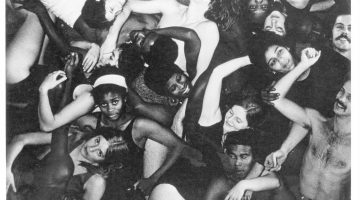By John Held, Jr.
When I first arrived in San Francisco in 1995, one of the first calls I made was to Ruth Asawa. I was a big admirer of Ray Johnson, who had gone to Black Mountain College with her in the late 1940s. Ray had gone on to become the impetus behind the New York Correspondence School, which spawned an international network of Mail Artists, of which I was a part. Ray had died earlier that year (January 13, 1995), and in preparation for an exhibition I was curating at the Stamp Art Gallery, where I had taken a position, I wanted to question Ruth about her intimate knowledge of the man.
“What do you want to know about him for? He’s dead,” was her response. I was shocked. I think I may have backed up, excused myself and promptly ended the conversation, such as it was. In hindsight, I believe Ruth’s curt reply was a desire to deflect thinking about someone important to her in her youth. Someone she had great affection for, and didn’t see the necessity in sharing her feelings with a stranger. I think it may also have had something to do with her love of fellow artists as individuals, as real people, not some fanciful idealization that admirers superficially adopted.
In time, I was able to rise above our strained first encounter, and was welcomed into her home, where she showed me her collection of Johnson “moticos,” small cardboard collages, that were posted to her by Ray in the 1950s. And I was stunned to see a work of hers done during her Black Mountain College years composed by using the BMC laundry rubber stamp, which hung in her bedroom. I was researching the use of rubber stamp art at the time, and had traced its earliest post-WW2 usage to the French artist Arman, who began using them in his work in the mid-1950s. Ruth had been using them as a creative tool in the late 1940s – an early harbinger of their increased usage by artists in the following decades.
Ruth was in the midst of a creative explosion at Black Mountain, made all the more surprising by the convoluted route that brought her there. She was the daughter of immigrant parents from Japan, who began farming in Norwalk, Southern California. She, like others of Japanese ancestry, were caught up in the diaspora of the time, first interred at Santa Anita and then shuffled off to Arkansas. After the war she went to a teachers collage in Milwaukee, but found out after graduation, that she was unemployable due to her race. She met Joseph and Annie Albers on a trip to Mexico and they encouraged her to attend Black Mountain. Once there, among an open minded community, she flourished, and without bitterness, never looked back. She noted in later years that she was a happy person, and that all her experiences up to that point had brought her to that state. There was no room for recrimination.

(Asawa on floor with several hanging sculptures) Photo by Nat Farbman for TimeLife, image owned by Getty Images
One person who brought her this happiness was her husband Albert Lanier, an architect by profession. Both Ruth and Albert attended Black Mountain. They were both very close to Ray Johnson. Albert told me that Ray had asked Ruth to marry him. Surprising, since Ray was gay, but at the time, I suppose, he was struggling with his sexuality. Albert asked Ray how he intended to support a wife – how was he going to pay for the shoes of his children? “I’ll make them,” answered Ray. When Ray and Albert graduated, they traveled to San Francisco together. Ray intended to live in The City and rented an apartment on Bernal Heights, but he was shortly thereafter summoned to New York by sculptor Richard Lippold, who had taught at Black Mountain, and they settled into a long relationship.
In 2001, I drove Ruth and Albert to the Sonoma Museum of Visual Art in Santa Rosa to see the exhibition, “Inside Out: Outside In,” curated by my friend Harley, on the work of Ray Johnson and May Wilson (a major correspondent of Johnson, artist in her own right, and mother of Bill Wilson, Ray’s primary historian). Albert was then using an oxygen tank to assist an ongoing respiratory ailment, which claimed his life in 2008.
In her later years, Ruth found increased recognition for her work. She has always been an icon in San Francisco, not only for her artistic accomplishments, but for mentoring several generations of schoolchildren. Her attachment to Black Mountain College was ongoing and instilled in her a devotion to education. I am but one of many she touched and humbled over the years. May she rest in peace, with a legacy that continues to grow in stature.







